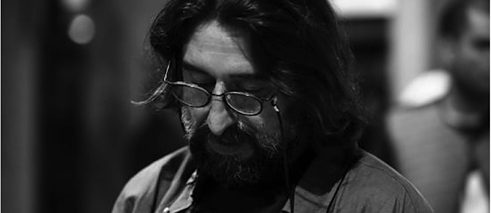Iranian Modernity
For a more complete picture of Iran

The Goethe-Institut is immersing itself in the contemporary arts scene of Iran with the three-month cultural programme Iranian Modernity. In an interview, Iranian music producer Ramin Sadighi expresses his pleasure over the growing cultural diversity of Tehran’s music scene and hopes for more space and fewer restrictions.
The objective of the three-month Iranian Modernity cultural programme is to demonstrate as many nuances as possible of Iran’s diverse art, literary and music scenes. A number of venues in Berlin are opening their doors for cultural exchange. The series begins the New Year on 21 January with concerts, public discussions and readings.
As part of the Plattenspieler (record players) series, author and musician Thomas Meinecke met with the Iranian music producer Ramin Sadighi to listen to records together in front of an audience at Berlin’s theatre Hebbel am Ufer (HAU). In the interview, Ramin Sadighi describes his experience of twenty years in the vibrant Tehran music scene.
Mr Sadighi, you have run your own label for almost twenty years and organize concerts with international artists in Iran. How has cultural life changed in Iran during this time?
It has changed immensely. At the beginning, I was absolutely uncertain whether there was a market for my music at all. The pop and the classical Persian music scenes were very active, but the other genres were quite under-represented. No one had invested in them.
Yet I am particularly interested in contemporary music: modern jazz and experimental music. During our collaborations with the record label, we noticed that there is a large audience for them. In the meantime, the numbers of concerts have grown. I am a little proud that I was involved in “growing” this scene.
How do you explain this great interest in the arts?
It’s not just a “hunger” for the arts; it is a lifestyle. Literature and music are part of our everyday lives. The interest in the arts is not so surprising to me, but that it is so diversified. This shows me that our society – especially its middle class – feels ties with the arts and is willing to evolve. If there are simply enough good incentives, the people are able to try out various new styles and continue to follow them.
Most of all, the encounters at the concerts are wonderful. The Tehran arts scene has such great potential, also for our neighbouring countries. But apparently no one was interested in discovering it.
In one talk you spoke of the “oriental perspective of the west on Iran.” What is wrong about this perspective?
One example: For their reports, correspondents usually stand in a slum of Tehran, if possible with a ruin in the background – whether its about football or the nuclear sanctions. That bothers me because this image is merely a fraction of the truth.
When foreigners come to Iran, in my case mostly artists, they get a completely different picture. We have a very active arts scene. Apart from the influence of the political situation, the people in Tehran live just like cosmopolitans in Paris or Frankfurt. People have a relatively normal life – but that is not at all interesting for the media. They would prefer something off the norm, to show something negative.
Are you restricted by censorship?
By not working in the mainstream industry, we don’t come so much in focus. The line that shouldn’t be crossed within this censorship system hardly affects my musical environment.
The cultural ministry is particularly strict about lyrics. There is very strong censorship in cases of anti-religious content – not only Islam, but also Christianity or Judaism. Or when it gets erotic. Generally, however, the decision is at the discretion of the censors, depending on whether they happen to be in good or bad mood.
Some clerics are also against women singing solos in public. Either they can only perform in front of women or as a duet or choir – then suddenly it’s all right when only women perform. Although there is still a debate going on, basically there has been a ban on solo female singers for years.
What other difficulties do you grapple with besides censorship; what are you lacking?
What makes our work difficult here, first of all, is copyright. There has been a copyright law since the beginning of the 1960s, but it has never been properly implemented since then. That is why it is difficult to protect the rights of artists and we can’t make any inroads against the pirated copy market. We respond by lowering prices so that it’s not worthwhile to buy pirated copies. That’s why we finance ourselves mainly through concerts.
For the future, I wish that we would have more concert venues at our disposal where these special musical encounters can take place. Tehran with its 15 million inhabitants has only twelve to thirteen places suitable for concerts or cultural events. We need more places where culture happens.
The sanctions – it was very risky to make investments – and the economic situation in the country are aspects that weaken the cultural sector. I am sure that with more cultural venues we could create more opportunities for the arts.
The interview was conducted by Achim Klapp.
Born in Austria in 1967, Ramin Sadighi and his family moved to Tehran shortly before the 1979 Islamic Revolution. In 1999, he founded the Iranian music label Hermes Records, which operates under the motto “Music for Music.” The producer has issued dozens of albums with new compositions from Iran, for example songs by the leading tar and setar player Hossein Alīzādeh. For his work for Iranian music, in 2015 the label received the Professional Excellence Award of the professional expo WOMEX.